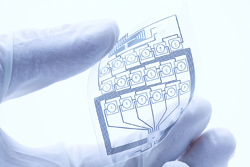New generation of flexible, transparent electronics
The ‘Multi-component oxides for flexible and transparent electronics’ (Multiflexioxides) project was initiated to develop new ceramic thin films containing multi-component oxides for use as transparent materials in rigid or flexible devices. Aside from the importance of the numerous potential applications, the use of flexible plastic substrates would facilitate dramatic changes in manufacturing processes enabling production of low-cost, environment friendly, high performance electronic devices. The researchers used simulation studies in combination with experimental data to identify multi-component oxides with optimal properties for the desired use. The inorganic nature of the metal oxides facilitates the use of existing and novel room temperature deposition techniques to produce chemically stable and long-lasting devices. Team members developed the necessary room temperature deposition techniques suitable for flexible substrates including low temperature chemical vapour deposition, chemical solution deposition and inkjet deposition. These techniques enable the use of large area roll-to-roll manufacturing whereby many circuits can be patterned at once onto the large surface of a roll of flexible ceramic material, significantly reducing cost and increasing throughput via fewer manufacturing steps. Most importantly, the Multiflexioxides researchers delivered the first instance of multi-component oxides as active semiconductors produced at low temperatures, providing a cost-effective, high performance alternative to silicon and organic semiconductors. Project outcomes pave the way for numerous future applications within the electronic devices sector due to the ready availability of high performance transparent materials for flexible uses together with the reduced manufacturing costs associated with the use of multi-component oxides. Thus, the Multiflexioxides project has the potential to dramatically change the global electronics industry while providing a major advantage to European manufacturers.







